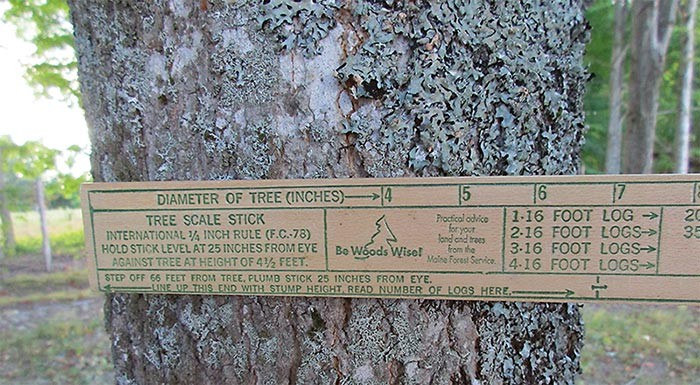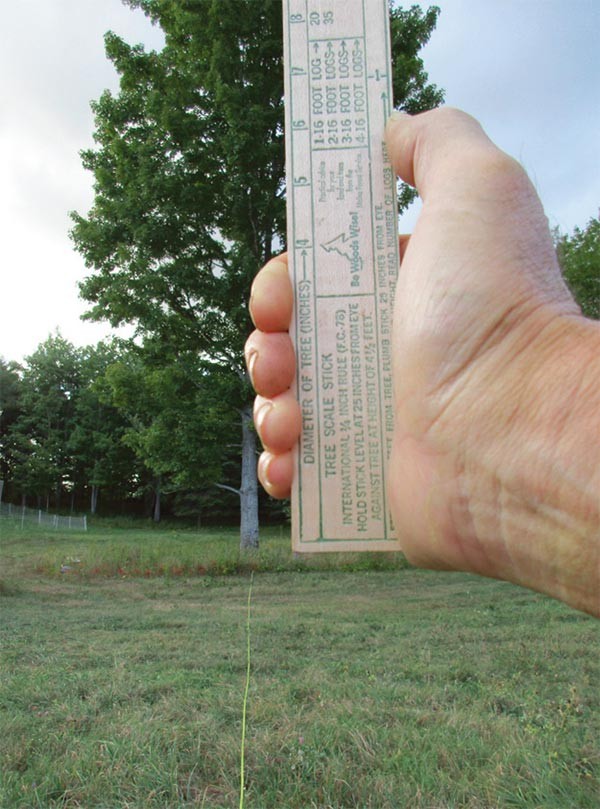In a world where modern technology can sweep us off our feet, the Biltmore stick is proof that simple, old-fashioned tools can still be of value. It is portable, affordable, and easy to use, making it a handy item for anyone who spends time in the forest, from professional foresters to landowners to loggers.
This low-tech tool looks like a shortened wooden yardstick, but with different increment markings. It is most often used for measuring the diameter of trees, but it has other uses.
The Biltmore stick was invented by forestry education pioneer Carl Alwin Schenck in the late 1890s. Schenck served with Gifford Pinchot – who would later become the first chief of the U.S. Forest Service – as a forester at Biltmore Estate in North Carolina. One of Biltmore Estate’s many claims to fame is that its thousands of acres of woodlands became America’s first professionally managed forests.
While conducting an inventory project in the Biltmore forests, it occurred to Schenck that the process of assessing the size and volume of trees could be made easier. At the time, the task of determining a tree’s size was a multistep process: after taking a raw measurement using an axe handle – then the timber cruiser’s measuring implement of choice – the actual diameter was then calculated using the trigonometric principle of similar triangles. Schenck noted that the job could be streamlined by measuring the tree’s width and standardizing the math. He set about creating a customized measuring device to do just that. Schenck’s specialty measuring stick later became known as the Biltmore stick because of its inventor’s connection with the estate.
Using the Biltmore stick to measure a tree is as simple as holding the stick against the tree and taking a reading. The directions on mine say to “hold stick level at 25 inches from eye against tree at height of 4.5 feet.” In practical terms, that’s arm’s length at breast height.
Line up the “zero” end of the stick flush with one side of the tree, and the number at the opposite side of the tree should give the approximate diameter of the trunk. Disparities can occur, mostly because trees are not perfectly round. A more precise measurement can be attained by taking a Biltmore stick reading at two or three sides of the tree and computing an average.
The Biltmore stick can also be used to measure the height of a tree (see photo at right). This is a little trickier but is handy for a forester’s quick assessment or a landowner’s reasonable estimate. To use the stick in this way, step off 66 feet from the tree – either by pacing or tape measure – and turn around to face the tree. Hold the Biltmore stick vertically, with the bottom (zero) end aligned with the base of the tree. The numbers along the right edge will give the number of 16-foot logs in the tree. The trained eye of a forester or harvester can use this reading, along with his or her knowledge of tree value, to predict with some accuracy the useable height of the tree.
A landowner interested in the tree’s height for reasons of curiosity or safety – for example, if the tree is to be felled near a structure and its height is a concern – can use this method as well. By determining the number of 16-foot sections in the tree, and adding extra to account for the upper branches, the height of the tree can be estimated. The result will be accurate enough for many situations, but probably not enough to bet the porch roof on.
Many models of the Biltmore stick include a chart that combines the diameter and height readings to determine the board feet of lumber in a given tree, though these numbers do not take into account any defects or other variables in the tree. Some Biltmore sticks have markings on the back that allow them to be used as log scale sticks.
The Biltmore stick remains a staple in many settings today. It is one of many tools in a forester’s tool belt, along with calipers, diameter tape, and more high-tech instruments. Other forest measurement options may be more accurate, but the Biltmore stick is quick and easy and requires no calculator. It also serves as an excellent management tool and an education aid for woodlot owners, silviculture students, outdoor enthusiasts, and backyard tree aficionados.




Discussion *